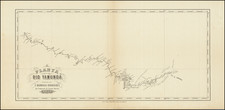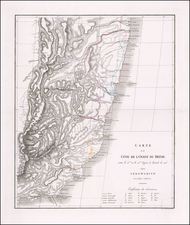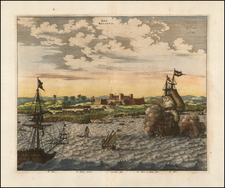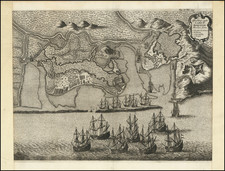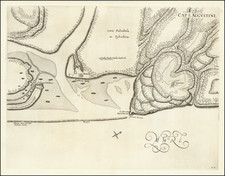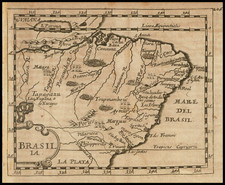Fine image of the shipwreck and mooring of Hans Staden, during his voyage to Brazil, published as part of De Bry's monumental Grands Voyages.
Hans Staden was a German soldier and explorer who voyaged to South America in the middle of the sixteenth century, where he was captured by the Tupinambá people of Brazil. He managed to survive and return safely to Europe. In his widely read account describing his travel and captivity, he claimed that the native people that held him captive practiced cannibalism. His reports Brazil dominated European interpretations of the region during the 16th and early 17th centuries.
The places named on the map are: Brikioka, Insula S. Vincetij, ItengeEhm, and S. Maro.
Hans Staden
In 1554, during a maritime expedition intended to deliver provisions to the beleaguered French Huguenot colony in Rio de Janeiro, Staden's ship ran aground near present-day São Vicente. Consequently, he found himself stranded in unfamiliar territory.
Subsequent to the shipwreck, Staden was taken prisoner by the Tupinambá, a tribe distinguished for their ritualistic cannibalism. Their tradition posited that consuming adversaries allowed for the assimilation of their attributes and prowess. Staden's previous captivity by the Tupiniquim, the Tupinambá's adversaries, exacerbated the tribe's suspicion towards him, leading them to surmise a potential alliance between him and their foes.
Throughout the duration of his nine-month captivity, Staden faced perpetual threats of sacrifice and ritualistic consumption. To evade such a fate, he employed various strategies, inclusive of demonstrating proficiency with the arquebus, asserting spiritual prowess, and emphatically distinguishing himself from the Portuguese, whom the Tupinambá deemed enemies.
A notable tactic involved Staden convincing the tribe of his divine protection. He exhibited this by public prayer and, leveraging his knowledge of European astronomy, predicted a lunar eclipse, asserting it as evidence of his spiritual ascendancy.
Such stratagems not only facilitated Staden's survival but also engendered a degree of trust and esteem from certain tribal members. After enduring myriad tribulations, Staden was eventually liberated through the intervention of a rival indigenous group.
Upon repatriating to Europe, Staden documented his Brazilian odyssey in the tome "True History: An Account of Cannibal Captivity in Brazil," published in 1557. This work has been esteemed as a pivotal primary source on indigenous Brazilian culture during the 16th century, while simultaneously influencing European conceptions of the New World.
Staden's narrative serves as an invaluable lens through which the multifaceted interactions between European explorers, colonizers, and indigenous populations during the early colonial period in Brazil can be examined. It illuminates the intricate dynamics that characterized the age of exploration.
Theodor de Bry (1528-1598) was a prominent Flemish engraver and publisher best known for his engravings of the New World. Born in Liege, de Bry hailed from the portion of Flanders then controlled by Spain. The de Brys were a family of jewelers and engravers, and young Theodor was trained in those artisanal trades.
As a Lutheran, however, his life and livelihood were threatened when the Spanish Inquisition cracked down on non-Catholics. De Bry was banished and his goods seized in 1570. He fled to Strasbourg, where he studied under the Huguenot engraver Etienne Delaune. He also traveled to Antwerp, London, and Frankfurt, where he settled with his family.
In 1590, de Bry began to publish his Les Grands Voyages, which would eventually stretch to thirty volumes released by de Bry and his two sons. The volumes contained not only important engraved images of the New World, the first many had seen of the geographic novelties, but also several important maps. He also published a collection focused on India Orientalis. Les Grands Voyages was published in German, Latin, French, and English, extending de Bry’s fame and his view of the New World.









